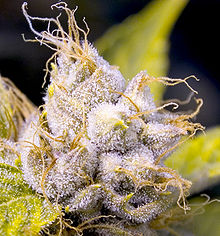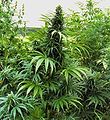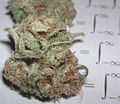- Marijuana strains
-
 A flowering cannabis plant
A flowering cannabis plant
Marijuana strains are either pure breeds or hybrid varieties of Cannabis, typically of the species C. indica or C. sativa. Strains are developed to highlight a specific combination of properties of the plant or to establish marketing differentiation. Strain names are typically chosen by their growers, and often reflect properties of the plant, such as taste, color, smell, or the origin of the strain.[citation needed]
Contents
Strain ambiguity
A strain may refer ambiguously to different forms of cannabis:
- Clone-only strain – A cannabis grower may grow a cannabis seed into a plant and find that this plant is unique in some way. The grower may make genetically identical clones of the plant and distribute these. A clone is the only way to propagate the exact genetic makeup that makes a strain unique, however, growing conditions greatly affects the plant and the final consumable product.
- Stable seed strain – For a cannabis breeder wishing to develop a new strain, the process is complicated and time consuming. It involves selectively choosing male and female cannabis plants and breeding them over the course of multiple generations. The final generation's seeds will have been stabilized by the breeder on the specific attributes chosen, though some genetic variation still exists among the seeds.
- Unstable seed strains – While these can be produced more quickly, plants grown from these seeds may have widely varying characteristics. Reputable seed shops will not distribute unstable seed strains, though some amateur growers might. Third-party growers may produce unstable derivatives from well known strains and misleadingly call them by their true strain name.
- Wild strains (Landraces) – Some strains, such as Colombian and Thai refer to cannabis plants found growing wild in certain regions. Typically, these plants are used as bases for the production of more specialized strains (e.g. G-13 or Haze).
Additionally, black market Cannabis dealers may distribute marijuana that is misleadingly called by a strain name. For example, Skunk and G13 may be used, but a lower grade may actually be sold.
Major strain types
The Cannabis genus is typically considered to have two species, Cannabis indica and Cannabis sativa.[1] A third species known as Cannabis ruderalis differs from the other two species in a few key ways. C. ruderalis is very short, produces only trace amounts of tetrahydrocannabinol (THC) and flowers independently of the photoperiod and according to age.[2]
Pure sativas are relatively tall (reaching as high as 4.5 meters), with long internodes and branches, and large, narrow-bladed leaves. Pure indica strains are shorter and bushier, have wider leaflets, and are often favored by indoor growers. Sativas bloom later than indicas, often taking a month or two longer to mature. The subjective effects of sativas and indicas are said to differ, but the ratio of tetrahydrocannabinol (THC) to cannabidiol (CBD) in most named drug strains of both types is similar (averaging about 200:1). Unlike most commercial drug strains, indica landraces often consist of a mixture of plants with varying THC/CBD ratios.[3] The relatively high CBD to THC ratio typical of hashish produced in regions where these landraces are grown (including Afghanistan and Pakistan) is useful for treating insomnia.[4]
In addition to "pure" indica, sativa, and ruderalis strains, hybrids strains with varying ratios of these three types are common. For example, the White Widow hybrid is purported to have about 60% "indica," and 40% "sativa" genetics. These hybrid strains have combinations of traits derived from both parental types. There are also commercial cross-bred hybrids which contain a mix of both ruderalis, indica and/or sativa genes (these hybrids are usually called autoflowering strains). "Lowryder" is the most famous auto-flowering hybrid and retains the auto-flowering characteristic of ruderalis plants, while also producing usable amounts of THC/CBD. Auto-flowering marijuana strains are considered advantageous by some growers due to their discreet size, short growing periods, and the fact that they do not rely on a change in light schedule to determine when to flower.[5]
Strain naming
Strains are often named by the breeder or grower to differentiate one from another. In competitive legal markets, such as in Amsterdam, there is significant pressure to create unique strains that dominate the market. This results in a number of distinct strain names that may refer to very similar cannabis.
Likewise, when a strain becomes popular, many breeders and growers may produce variations of the same strain using the same or similar name.
Breeding new strains
Breeding involves pollinating a female cannabis plant with male pollen. This will happen naturally. However, the intentional creation of new strains typically involves selective breeding in a controlled environment.
Often male plants, once identified by their ball-like stamen, will be separated from female flowers. This prevents accidental fertilization of the female plants, either to facilitate sinsemilla flowering or to provide more control over which male is chosen. Pollen produced by the male is caught and stored until it is needed.
The seeds produced by a germinated female will be F1 hybrids of the male and female. These offspring will not be identical to their parents. Instead, they will have characteristics of both parents. Advanced techniques can stabilize certain characteristics.
A common technique to stabilize a cannabis strain is called "cubing", in which the breeder will seek specific traits in the hybrid offspring (e.g. greater resin production, tighter node spacing, etc.) and breed said offspring with a parent plant. The same traits are sought in the new inbred offspring, which are then again bred with the original parent plant. This process is called cubing because it usually repeated across three (or possibly more) generations before a strain can be considered at least somewhat stable.
Seed shops sell both pure strains that have specific aspects stabilized as well as unstabilized hybrids that may be of questionable quality.
Most cannabis strains used today in North America are asexually propagated Sativa strains, that were bred hydroponically to produce large amounts of "bud".
References
- ^ Small, E. and A. Cronquist. 1976. A practical and natural taxonomy for Cannabis. Taxon 25(4): 405–435.
- ^ Greg Green (2001). The Cannabis Grow Bible (4th ed.). p. 47.
- ^ Hillig, Karl W. and Paul G. Mahlberg. 2004. A chemotaxonomic analysis of cannabinoid variation in Cannabis (Cannabaceae). American Journal of Botany 91(6): 966-975. Retrieved on 22 February 2007
- ^ Cervantes, Jorge. Marijuana Horticulture: The Indoor/Outdoor Medical Grower's Bible. Van Patten Publishing. ISBN 1-878823-23-X.
- ^ Auto-flowering Cannabis Strain: Best light schedule?
External links
- Marijuana Strain Library
- Search Marijuana Strains
- Leafly.com
- Marijuana Strain Reviews - Potfessor.com
- The Home to Autoflowering cannabis
- Autoflowering Feminized Cannabis Strains
Cannabis General Preparations Usage Effects Short-term · Long-term (dependence · withdrawal · respiratory disease) · Cannabidiol · Cannabinoids · Delta-9-tetrahydrocannabinol (Δ9-THC) · Endocannabinoid systemNotable strains Acapulco Gold · BC Bud · Holland's Hope · G-13 · Kush · Netherlands Weed · Northern Lights · Panama Red · Quebec Gold · Skunk · White WidowOrganizations Culture Categories:- Cannabis strains
Wikimedia Foundation. 2010.










